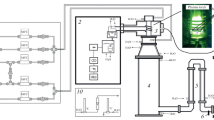Abstract
Three basic variants of bireactor electronuclear systems are discussed. It is shown that the most effective, from the standpoint of the best output characteristics and safe operating regimes, are bireactor systems with a booster operating on enriched uranium and a liquid-cadmium rectifier. Monte Carlo simulation is used to show that during operation of the setup conditions can be created under which the destruction of an intermediate layer makes such systems supercritical (k eff > 1). This can be avoided using a special construction of the rectifier with liquid cadmium. Cascade nuclear systems possess substantial advantages over other nuclear setups (critical reactors, single-reactor electronuclear systems), making it possible to decrease the proton current by approximately a factor of 10 and ensure in the process the required power level and neutron flux, and the presence of a fast and thermal cores makes it possible to burn efficiently not only transuranium elements but also to transmute fission products – cesium, iodine, technetium, which have a high capacity for penetrating into the biosphere.
Similar content being viewed by others
REFERENCES
Proceedings of the International Conference ADTTA 01, November 12–15, 2001, Reno, Nevada.
Proceedings of the 10th International Conference on Emerging Nuclear Systems, September 28, 2000, Petten.
S. A. Bznuni, V. M. Zhankochyan, A. G. Khudaverdyan, et al., “Monte Carlo simulation of the parameters of two-reactor electronuclear systems,” At. Énerg., 92, No.5, 344–351 (2002).
B. R. Bergel'son, A. A. Nikitin, V. T. Starostin, et al., “Subcritical setup (target–blanket) for actinide transmutation,” At. Énerg., 82, No.5, 341–361 (1997).
S. A. Bznuni, V. S. Barashenkov, V. M. Zhamkochyan, et al., “Monte Carlo simulation of the parameters of a subcritical cascade reactor based on liquid-salt and liquid-metal technology,” Preprint OIYAI R2/2001-124, Dubna (2001).
V. F. Kolesov and B. Ya. Guzhovskii, “Increasing the efficiency of electronuclear transmutation setup by multisectionalizing the blanket structure,” At. Énerg., 76, No.1, 71–77 (1994).
V. F. Kolesov, S. K. Shtarev, V. Kh. Khoruzhii, and A. K. Zhitnik, “Effectiveness of electronuclear setup with a blanket based on fused salts and neptunium multiplying target,” At. Énerg., 79, No.1, 40–45 (1995).
V. F. Kolesov and V. Kh. Khoruzhii, “Neutron characteristics of models of a cascade two-section blanket,” At. Énerg., 88, No.5, 330–337 (2000).
V. F. Kolesov, N. V. Zav'yalov, I. A. Ivanin, et al., “Experimental investigation of models of a cascade blanket of an electronuclear system,” At. Énerg., 92, No.1, 42–50 (2002).
Yu. M. Ado, D. V. Gorbatkov, V. P. Kryuchkov, and V. N. Lebedev, “Some advantages and disadvantages of an electronuclear reactor based on a two-section blanket,” in: 8th International Conference on Emerging Nuclear Systems, ICENES 96, Obninsk, June 24–28, 1996, Vol. 2, pp. 587–590.
V. V. Seliverstov, “Multiplication of neutrons from an external source in cascade subcritical systems with unilateral neutron coupling,” At. Énerg., 81, No.5, 378–390 (1996).
P. N. Alekseev, V. V. Ignat'ev, O. E. Kolyaskin, et al., “Cascade subcritical enhanced-safety reactor,” At. Énerg., 79, No.5, 327–337 (1995).
A. Dudnikov, P. Alekseev, N. Kotkin, et al., “Transmutation of long-lived radioactive waste in critical and cascade subcritical molten salt reactors,” in: Proceedings of the 3rd International Conference on ADTTA, June 7–11, 1999, Praha.
P. N. Alekseev, V. V. Ignat'ev, O. E. Kolyaskin, et al., “Cascade subcritical reactor as a fuel-cycle component,” At. Énerg., 79, No.4, 243–252 (1995).
S. A. Bznuni, A. H. Khudaverdyan, V. M. Zhamkochyan, et al., “Monte Carlo modeling of bireactor electronuclear system,” Comp. Methods in Sci. Eng., 2, No.1–2, 21–29 (2002).
V. S. Barashenkov, “Monte Carlo simulation of ionization and nuclear processes initiated by hadron and ion beams in media,” Comp. Phys. Comm., 126, 28–31 (2000).
L. P. Abagyan, N. O. Bazazyants, W. Gudowski, and A. Polanski, Group Constants for Calculating Nuclear Reactors, Énergoatomizdat, Moscow (1981).
V. S. Barashenkov, W. Gudowski, and A. Polanski, “Integral high-energy nucleon-nucleus cross sections for mathematical experiments with electronuclear facilities,” in: Proceedings of the 3rd International Conference on ADTTA, June 7–11, 1999, Praha.
Yu. Briesmeister, “General Monte Carlo N-particle transport code,” Report LA-12625-M (March 1997).
Author information
Authors and Affiliations
Rights and permissions
About this article
Cite this article
Bznuni, S.A., Zhamkochyan, V.M., Khudaverdyan, A.G. et al. Cascade Electronuclear Systems with a Liquid-Cadmium Rectifier. Atomic Energy 94, 173–178 (2003). https://doi.org/10.1023/A:1024202302999
Issue Date:
DOI: https://doi.org/10.1023/A:1024202302999




